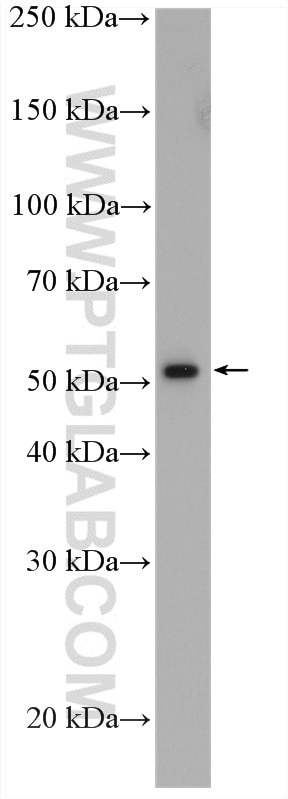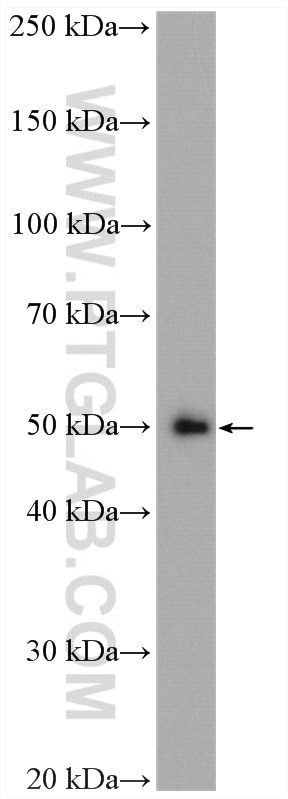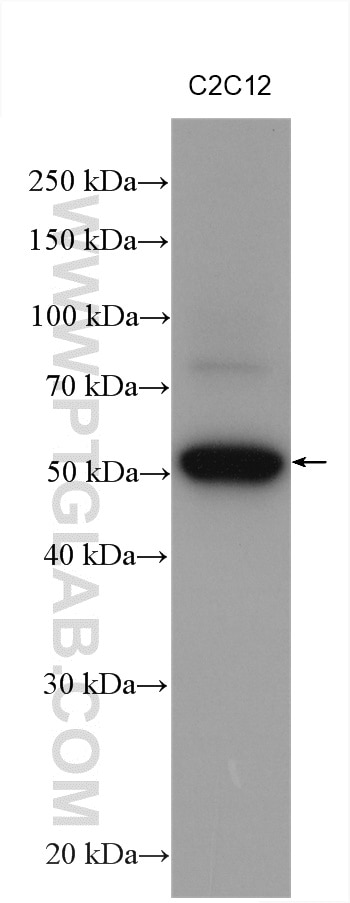- Phare
- Validé par KD/KO
Anticorps Polyclonal de lapin anti-TEAD1
TEAD1 Polyclonal Antibody for WB, ELISA
Hôte / Isotype
Lapin / IgG
Réactivité testée
Humain, souris et plus (1)
Applications
WB, IF, ELISA
Conjugaison
Non conjugué
N° de cat : 13283-1-AP
Synonymes
Galerie de données de validation
Applications testées
| Résultats positifs en WB | cellules BGC-823, cellules A375, cellules C2C12 |
Dilution recommandée
| Application | Dilution |
|---|---|
| Western Blot (WB) | WB : 1:500-1:1500 |
| It is recommended that this reagent should be titrated in each testing system to obtain optimal results. | |
| Sample-dependent, check data in validation data gallery | |
Applications publiées
| KD/KO | See 1 publications below |
| WB | See 10 publications below |
| IF | See 1 publications below |
Informations sur le produit
13283-1-AP cible TEAD1 dans les applications de WB, IF, ELISA et montre une réactivité avec des échantillons Humain, souris
| Réactivité | Humain, souris |
| Réactivité citée | rat, Humain |
| Hôte / Isotype | Lapin / IgG |
| Clonalité | Polyclonal |
| Type | Anticorps |
| Immunogène | TEAD1 Protéine recombinante Ag4082 |
| Nom complet | TEA domain family member 1 (SV40 transcriptional enhancer factor) |
| Masse moléculaire calculée | 426 aa, 47, 9 kDa |
| Poids moléculaire observé | 52 kDa |
| Numéro d’acquisition GenBank | BC026959 |
| Symbole du gène | TEAD1 |
| Identification du gène (NCBI) | 7003 |
| Conjugaison | Non conjugué |
| Forme | Liquide |
| Méthode de purification | Purification par affinité contre l'antigène |
| Tampon de stockage | PBS avec azoture de sodium à 0,02 % et glycérol à 50 % pH 7,3 |
| Conditions de stockage | Stocker à -20°C. Stable pendant un an après l'expédition. L'aliquotage n'est pas nécessaire pour le stockage à -20oC Les 20ul contiennent 0,1% de BSA. |
Informations générales
TEAD1 belongs to a protein family that share the TEA/ATTS domain. It acts as a transcriptional factor by binding to the GT-IIC and Sph(I 1 II) enhansons in the simian virus 40 (SV40) enhancer. Also it can modulate SV40 late transcription together with large T antigen. The transcriptional activity of TEAD1 required several regions of the proteins , a TBP-associated factors and a limiting transcriptional intermediary factors. TEAD1 also preforms an essential role in the Hippo signaling pathway. TEAD1 regulates gene expression of YAP1 and WWTR1/TAZ, thus mediating cell proliferation, migration and epithelial mesenchymal transition induction. TEAD is preferentially expressed in skeletal muscle. Lower levels in pancreas, placenta, and heart.
Protocole
| Product Specific Protocols | |
|---|---|
| WB protocol for TEAD1 antibody 13283-1-AP | Download protocol |
| Standard Protocols | |
|---|---|
| Click here to view our Standard Protocols |
Publications
| Species | Application | Title |
|---|---|---|
Cancer Lett EGFR/c-myc axis regulates TGFβ/Hippo/Notch pathway via epigenetic silencing miR-524 in gliomas. | ||
Cancers (Basel) WISP2/CCN5 Suppresses Vasculogenic Mimicry through Inhibition of YAP/TAZ Signaling in Breast Cancer Cells. | ||
Int J Mol Sci Role of Clostridium perfringens Enterotoxin on YAP Activation in Colonic Sessile Serrated Adenoma/ Polyps with Dysplasia. | ||
Dig Dis Sci TEA Domain Transcription Factor 1 Inhibits Ferroptosis and Sorafenib Sensitivity of Hepatocellular Carcinoma Cells | ||
Biomed Pharmacother YAP1-TEAD1-Glut1 axis dictates the oncogenic phenotypes of breast cancer cells by modulating glycolysis. | ||
Oncol Rep YAP is overexpressed in clear cell renal cell carcinoma and its knockdown reduces cell proliferation and induces cell cycle arrest and apoptosis. |





